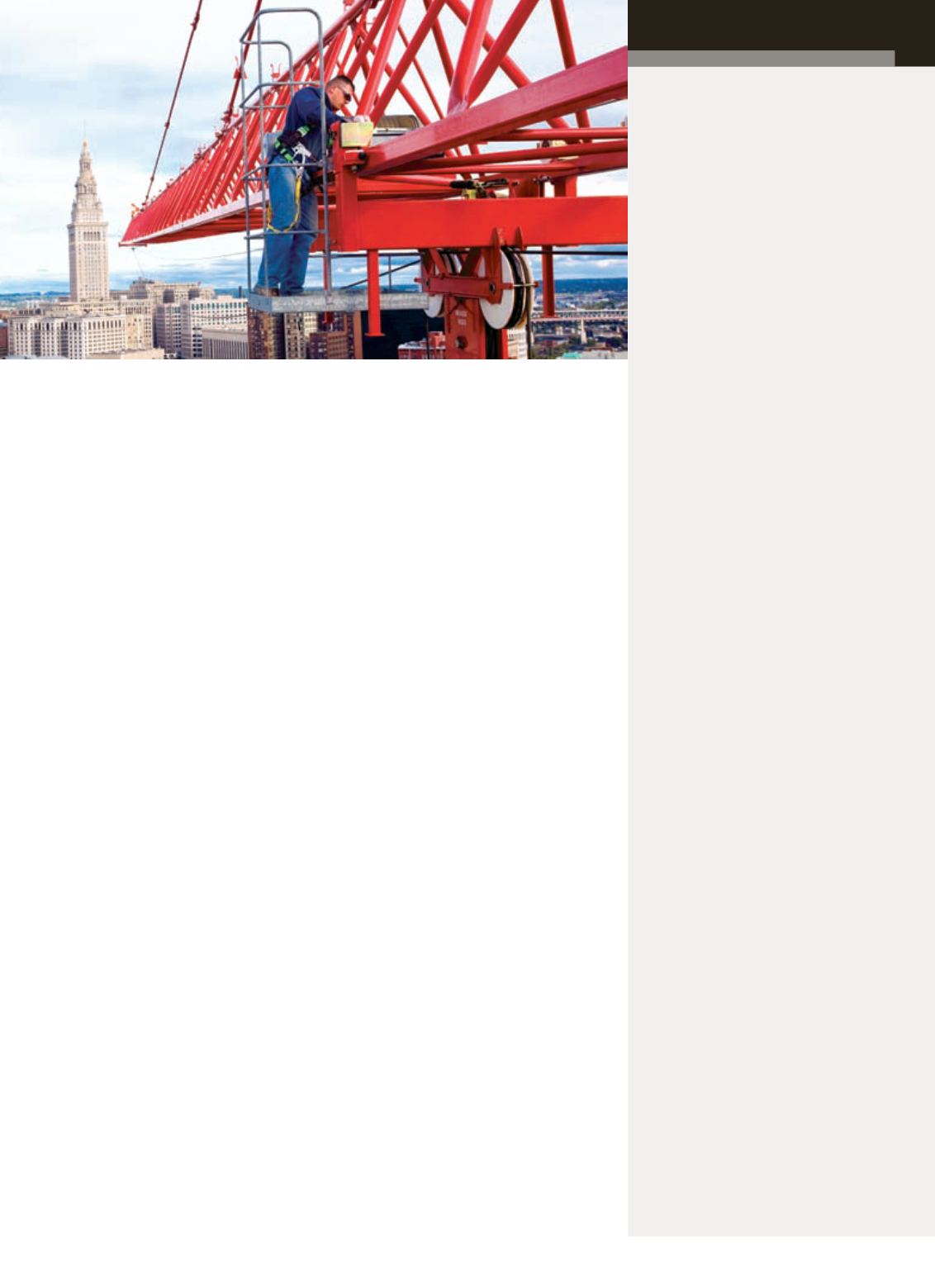
23
AUGUST 2013
ACT
RIGGING REVIEW
failure analysis, among other things, once
an accident has occurred.
Bristow recalls one particular case
involving a 1988 Krupp KMK5100. While
working on a water well installation
project in northern Mississippi, the
crane was being utilized to assist in the
extraction of a well casing. While in the
process of applying force to the casing, the
crane’s upper structure suddenly failed
and separated at the rear, directly behind
the rotation bearing and right in front of
the counterweights.
The break was so clean and so swift
that it caused a split between the upper
engine and the pump drive gearbox. The
boom fell and landed on a $350,000 drill
rig that was deemed a total loss by the
insurance company. The subject crane
was also deemed a total loss at $195,000,
with additional clean up and recovery
costs totaling some $40,000. The resulting
investigation revealed that a sticker on the
upper cab indicated that the crane had
been inspected and was actually certified
30 days prior to the accident.
Recalling the incident, Bristow notes his
theory. “Obviously one of two scenarios
took place,” he says. “Either an inspection
was never performed, and the sticker was
provided for a fee, or the inspector failed
to recognize a preexisting fracture that
measured 12.5 inches vertical on the right
side, 30 inches horizontal across the rear,
and 12 inches vertical on the left. You be
the judge.”
Regardless of what caused the fracture
to go unnoticed, the outcome remained
the same – equipment and property
damage totaling $585,000. And though
this particular case was fortunate in the
fact that there were no injuries, not all
accidents have the same results.
Crane inspectors are in a unique position
to look at the crane through a lens that
neither the crane operator, lift director,
general contractor, nor anyone else for
that matter, is practiced enough to see
through. They typically have time on their
side and can methodically go through a
crane’s mechanical, structural and boom
components with a great deal of diligence.
Routine inspections
According to Ray Feidt, CCAA president
and inspection/training manager for
Stephenson Equipment, routine and
regular crane inspection is extremely
important.
“The reason for routinely inspecting
a crane is to have a consistent review of
the condition of the crane and its specific
components,” Feidt says. “If a component
is beginning to show wear, then that
component must be carefully analyzed
during every inspection. An immediate
decision must be made as to whether the
component will be repaired, replaced or
continue to be monitored.”
Most companies in the construction
industry find common ground when it
comes to issues of safety. The heartache –
both financial and personal – a company
goes through when a serious incident
occurs on a jobsite affects almost every
company in the same way. Accidents have
a profound impact on everything from
employee morale to operating margin.
Because of this, safety as a category is
ever evolving. New technology, better
procedures and innovations in science all
play a pivotal role in safely moving the
industry forward. Each of the individuals
on a jobsite – regardless of his or her
position or role – has a duty to act safely.
Whether we’re advocating for more
adequately trained operators, riggers,
signalpersons or inspectors, when we
break it down fundamentally, we’re
ultimately arguing for a better industry.
Having higher standards for crane
inspectors to aspire to is just another
piece in the ever-evolving puzzle of crane
and rigging operations.
■
Inspection items:
Among the items that must be inspected
are: the crane structure, sheaves and
drums, pins and bearings, brakes, safety
devices, engine, tires, hydraulic hoses,
electrical components, pumps, valves
and wire ropes. See the OSHA regulation
for a full list of items that must be
inspected.
Three questions to ask
your crane inspector:
■
How much experience do you have
with this particular crane model?
■
What type of experience does you
have with this particular crane?
(As an operator, technician, etc.)
■
What type of insurance does your
company carry?
(General liability, professional liability,
etc.)
Six times your crane
should be inspected:
WHEN IT IS MODIFIED
Anytime a crane is modified, a qualified
person must inspect the modification.
WHEN IT IS REPAIRED OR ADJUSTED
Anytime a crane has had a repair to a
component that relates to safe operation,
it must be inspected by a qualified person
prior to initial use.
AFTER IT HAS BEEN ASSEMBLED
After assembly is completed, the crane
must be inspected by a qualified person.
Tower cranes must also have a pre-
assembly inspection
DURING A SHIFT
OSHA no longer requires a daily
inspection; instead, shift inspections
must be performed by a competent
person. Documentation is not required
for this inspection.
MONTHLY
The monthly inspection is simply a
documented shift inspection done by
a competent person. The employer is
responsible for maintaining the last three
monthly inspections, and they must be
made available to an inspector.
ANNUALLY (COMPREHENSIVE)
This inspection must be performed
by a qualified person and must be
documented. Disassembly is required, as
necessary, to complete the inspection.
In addition, a functional test must be
performed. Any deficiencies must be
assessed to determine if they represent
safety concerns. If so, the crane must
be taken out of service until repairs are
made.
PHOTO COURTESY OF ALL
ERECTION & CRANE RENTAL.


